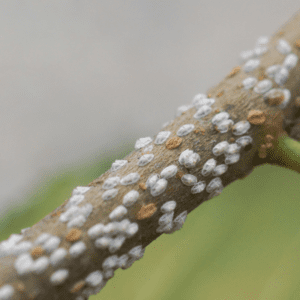Trees are an important part of our Texas landscape. Yet, we sometimes take them for granted. These gentle giants seem to be indestructible and a permanent part of the landscape. But there are many problems that trees in Texas face and if we don’t take care of our trees, the next generation won’t be able to enjoy them.
Today we are talking about one of the strangest tree pests in Texas, tree scale. Tree scale or scale insects are small flat insects that feed on the sap of trees. What makes them so strange is that to the naked eye, they just look like natural bumps on a branch. That’s because the tree scale doesn’t resemble an insect at all. 
Life Cycle of Scale Insects
Tree scale is tricky to treat unless you know their life cycle. Their protective coatings make most pesticides a hit or a miss. In the spring, adults emerge from their overwintering spots under a protecting wax shelter and lay their eggs. The eggs hatch over the course of three weeks. The pupae, or “crawlers” are born with legs. They move around the tree in search of the perfect spot to tap into the tree. After they find a suitable spot, they bite into the tree and start sucking sap. As they grow into adults they lose their legs and become permanent fixtures of the tree.
How To Identify Tree Scale
Scale insects are small, flat, oval-shaped insects with a waxy shell used for protection. They feed on trees and shrubs by extracting sap with their piercing mouthparts. Scale insects come in three varieties with their own unique traits.
Soft Scale – Soft scale insects are protected by a waxy substance they secrete over themselves. They excrete honeydew, which attracts ants and can develop sooty mold.
Armored (Hard Scale) – Armored scale insects are smaller and rounder than soft scale insects and produce a hard shell that protects them from predators. Armored scale does not produce honeydew.
Mealybug Scales – Mealybug Scales are covered with a white, cotton-like material that protects them from excessive heat and moisture loss. Unlike their soft and armored cousins, most species keep their legs.
Symptoms of Tree Scale
Most trees can handle a small amount of scale insect inhabitants, but an infestation can weaken the plant and make it susceptible to other pests and disease. If you notice your trees exhibiting the following symptoms, then you should check for a tree scale infestation.
- Yellowing of leaves
- Early defoliation
- Stunted growth
- Bumps or growths (insects) on branches

How to Treat Tree Scale
Tree scale can be tricky to treat if you don’t have the timing down. Horticultural oil or dormant oils work well for controlling adults as well as the crawlers. The best time to fight tree scale is in the spring after the crawlers have hatched. At this stage, they are very vulnerable to natural predators and pesticides. Other ways to control tree scale are:
- Prune and dispose of infected branches.
- Plant flowers that attract natural predators such as ladybugs, wasps, bees, and lacewing.
Hire the Lawn and Tree Care Experts at Ashton Walden
When it comes to trees and shrubs, call the professionals at Ashton Walden. At Ashton Walden, we have been dealing with Texas trees and tree problems since 1997. Our tree and shrub program is designed to give your ornamentals the nutrients they need to stay healthy.
Call us at (806) 632-3571 or leave us a message here. Check out our monthly blog for more lawn care tips. Follow us on Facebook and Twitter to keep up on our latest deals and announcements.